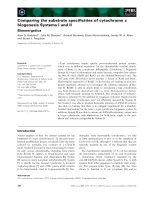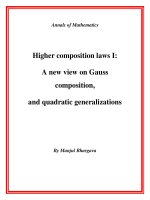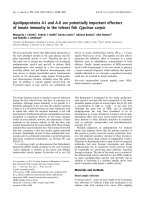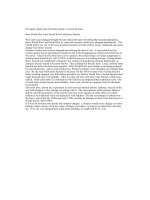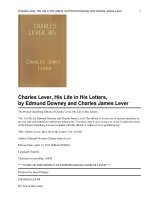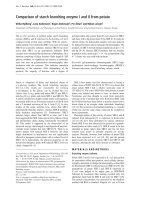General chemistry i and II general
Bạn đang xem bản rút gọn của tài liệu. Xem và tải ngay bản đầy đủ của tài liệu tại đây (2.59 MB, 187 trang )
ACE GENERAL CHEMISTRY I AND II
(T HE E ASY G UIDE
TO
A CE G ENERAL C HEMISTRY I
AND
II)
B Y : D R . H OLDEN H EMSWORTH
Copyright © 2015 by Holden Hemsworth
All rights reserved. No part of this publication may be reproduced, distributed, or
transmitted in any form or by any means, including photocopying, recording, or other
electronic or mechanical methods, without the prior written permission of the publisher,
except in the case of brief quotations embodied in critical reviews and certain other
noncommercial uses permitted by copyright law.
www.pdfgrip.com
DISCLAIMER
Chemistry, like any field of science, is continuously changing and new
information continues to be discovered. The author and publisher have
reviewed all information in this book with resources believed to be reliable
and accurate and have made every effort to provide information that is up to
date and correct at the time of publication. Despite our best efforts we cannot
guarantee that the information contained herein is complete or fully accurate
due to the possibility of the discovery of contradictory information in the
future and any human error on part of the author, publisher, and any other
party involved in the production of this work. The author, publisher, and all
other parties involved in this work disclaim all responsibility from any errors
contained within this work and from any results that arise from the use of this
information. Readers are encouraged to check all information in this book
with institutional guidelines, other sources, and up to date information.
The information contained in this book is provided for general
information purposes only and does not constitute medical, legal or
other professional advice on any subject matter. The information author
or publisher of this book does not accept any responsibility for any loss
which may arise from reliance on information contained within this book or
on any associated websites or blogs.
www.pdfgrip.com
WHY I CREATED THIS STUDY GUIDE
In this book, I try to breakdown the content covered in the typical two
semester General Chemistry course in college for easy understanding and to
point out the most important subject matter that students are likely to
encounter. This book is meant to be a supplemental resource to lecture notes
and textbooks to boost your learning and go hand in hand with your studying!
I am committed to providing my readers with books that contain concise and
accurate information and I am committed to providing them tremendous
value for their time and money.
Best regards,
Dr. Holden Hemsworth
Your reviews greatly help reach more students. If you find this book
helpful, please click below to leave a review on Amazon or to share the
book on Facebook. Nothing helps more than a few kind words.
www.pdfgrip.com
TABLE OF CONTENTS
CHAPTER 1: Introduction to Chemistry
CHAPTER 2: Components of Matter
CHAPTER 3: Stoichiometry of Formulas and Equations
CHAPTER 4: Chemical Reactions
CHAPTER 5: Quantum Theory and Atomic Structure
CHAPTER 6: Electron Configuration and Periodic Properties
CHAPTER 7: Chemical Bonding
CHAPTER 8: Geometry of Molecules
CHAPTER 9: Bonding Theories
CHAPTER 10: Gases and Gas Laws
CHAPTER 11: Thermochemistry
CHAPTER 12: Solutions
CHAPTER 13: Chemical Kinetics
CHAPTER 14: Chemical Equilibrium
CHAPTER 15: Acid Base Equilibrium
CHAPTER 16: Solubility Equilibrium
CHAPTER 17: Electrochemistry
CHAPTER 18: Nuclear Chemistry
www.pdfgrip.com
CHAPTER 1 – INTRODUCTION TO
CHEMISTRY
What is Chemistry?
Chemistry is the branch of science concerned with the understanding of
matter; the substances it is composed of and their properties, as well as the
ways in which they interact and change to form new substances.
Matter
Matter is anything that has mass and takes up space. Mass is the amount of
matter an object contains; a way of quantifying matter. Matter exists in three
physical states.
Solid – matter with fixed shape and volume (rigid)
Liquid – matter with a fixed volume but indefinite shape
Takes on the shape of the container it is in
Gas – matter without a fixed shape or volume
Conforms to the volume and shape of its container
www.pdfgrip.com
Physical and Chemical Properties
Physical property – characteristics that can be measured and
observed without changing the chemical makeup of the substance
Examples: color, melting point, boiling point, density,
etc.
Physical change – a substance changes its physical appearance but
does not change identity
Changes in state (e.g., liquid to gas, solid to liquid) are
all physical changes
Chemical property – any property that becomes evident during a
chemical reaction
Examples: pH, corrosiveness, etc.
Chemical change (aka chemical reactions) – a substance is
transformed into a chemically different substance
www.pdfgrip.com
Mixtures
Mixtures are combinations of two or more substances in which each
substance keeps its chemical identity. Mixtures can be separated into two or
more substances.
Heterogenous mixtures – mixture that is divided into different
regions of appearance and properties
Results from components not being distributed
uniformly
Homogenous mixtures – mixture that is uniform throughout
without any visible separations
Solutions are homogenous mixtures
Where a solid (the solute) is dissolved in a
liquid (the solvent)
www.pdfgrip.com
Elements and Compounds
Pure substances have definite and consistent composition and are composed
of elements or compounds.
Element - substance that can’t be broken down into other
substances by chemical means
Compound – substance formed from two or more chemical
elements that are chemically bonded together
Law of definite proportions
Pure compounds always contain exactly the same
proportions of elements by mass
www.pdfgrip.com
Energy
Energy is the capacity to do wok.
Kinetic energy – energy possessed by an object due to its motion
Potential energy – energy stored in matter because of its position
or location
Something suspended in the air has higher potential
energy than something sitting on the ground
Total Energy = potential energy + kinetic energy
Lower energy states are more stable in nature
Law of conservation of energy
Energy can’t be created or destroyed…but it can be
transformed
Example: potential energy can be converted to
kinetic energy
Energy is always conserved
www.pdfgrip.com
Scientific Method
The scientific method is a technique for investigation that is used to answer
scientific questions.
Hypothesis - a proposed explanation made on observations or
limited evidence that serves as the starting point for further
investigation
Theory – explanation of general principles of a phenomena that
has been repeatedly tested and observed
Fact – indisputable truth
Steps in scientific approach
Observations, Hypothesis, Experiment, Development of
a model or theory, Further experimentation
www.pdfgrip.com
Measurements
Measured quantities consist of a number and a unit.
Units are standardized in the form of the International System
called SI units
Units have associated prefixes to make them easier to use and
reports
Conversion factors – a mathematical multiplier used to convert a
quantity expressed in one set of units into an equivalent quantity
expressed in
Example: 1 yard = 3 feet (10 yard = 30 feet)
Scientific Notation
Scientific notation is a way of handling very large or very small
numbers
Scientific notation for a number only contains significant figures
Examples
525,000 = 5.25 x 105
2,301,000,000 = 2.301 x 109
0.000000000670 = 6.70 x 10-10
Consider the following: 0.000023 = 2.3 x 10-5
The exponent on 10 is the number of places the decimal
point must be shifted to give the number in its long form
Positive exponent, shift the decimal point to the
www.pdfgrip.com
right
Negative exponent, shift the decimal point to
the left
Significant Figures
All non-zero numbers are always significant
1, 2, 3, 4, 5, 6, 7, 8, and 9
Zeroes in between non-zero numbers are always significant
10001 – 5 sig figs
A final zero or trailing zeroes in the decimal portion are
significant
0.00500 – 3 sig figs
1255.0 – 5 sig figs
All zeroes to the left of a decimal point and that add value to a
number are significant
100.0 – 4 sig figs
0.1 – 1 sig fig
In this case, the zero adds no value; it is there to
avoid confusion and by convention
Exact Number
Exact numbers are considered to have an infinite number of
significant figures
They do not affect accuracy or precision of an expression
they are in
You do not have to consider the significant figures in
exact numbers when doing calculations
Conversion factors are exact numbers
1 yard = 3 feet (there are exactly 3 feet in a yard)
1 foot = 12 inches (there are exactly 12 inches in a foot)
Multiplication and Division Significant Figures
www.pdfgrip.com
First perform all operations and arrive at an answer
The answer should have the same number of significant figures as
the number with the least amount of significant figures used in the
calculations
Addition and Subtraction Significant Figures
First perform all operations and arrive at an answer
In addition and subtraction you only have to consider the
significant figures in the decimal portion
The answer should contain no more decimal places than
the number with the least amount of digits in the decimal
portion
Multiplication/Division Combined with Addition/Subtraction
Follow order of operations
If the next operation to be performed is in the same group as the
previous operation then don’t round the calculation
For example when you perform division and then
multiplication, you would not round the calculation
If the next operation to be performed is in the other group from the
previous operation then you would round the answer using the
rules before moving on to the next operation
Example: You perform division and the next operation is
subtraction
You would first round the result of the division
using the significant figure rules for division
before you perform subtraction
Accuracy and Precision
Accuracy – how close a result is to the real value
Precision – how close repeated measurements are in relation to one
another
www.pdfgrip.com
Accuracy vs. Precision:
Uncertainty
Uncertainty – error in a measurement
Expressed as a standard deviation
When making a measurement involving an instrument, the
measurement is made with one uncertain digit
Example:
You might record the measurement as 20.03
The 3 is an uncertain digit because it is
estimated and can’t be read off exactly from the
instrument
www.pdfgrip.com
Temperature
Temperature is commonly quantified using the three units: kelvin, Celsius,
and Fahrenheit.
Kelvin (K) – “absolute temperature scale”
Starts at absolute zero
Contains only positive values
Celsius (˚C) – “water based scale”
0˚C – freezing point of water
100˚C – boiling point of water
Most commonly used scale around the world
Fahrenheit (˚F) – “mercury based scale”
Commonly used in the US
Converting Temperatures
Formula for Kelvin to Fahrenheit: (9/5)(K - 273) + 32
Formula for Kelvin to Celsius: K – 273
Formula for Celsius to Kelvin: ˚C + 273
Formula for Celsius to Fahrenheit: ˚C x (9/5) + 32
Formula for Fahrenheit to Kelvin: (5/9)(˚F – 32) + 273
Formula for Fahrenheit to Celsius: (5/9)(˚F - 32)
www.pdfgrip.com
CHAPTER 2 – COMPONENTS OF MATTER
Components of Matter (Definitions)
Element - substance that can’t be broken down into other
substances by chemical means
Molecule - a combination of two or more atoms
Compound – substance formed from two or more chemical
elements that are chemically bonded together
Mixture - two or more elements (or compounds) mingling without
any chemical bonding
www.pdfgrip.com
Laws of Matter
Law of Mass Conservation
Total masses of substances involved in a chemical
reaction do not change
Number of substances and their properties can
change
Law of Definite Proportions:
Pure compounds contain exactly the same proportions of
elements by mass
Law of Multiple Proportions
If two elements react to form more than one compound,
then the ratios of the masses of the second element
which combine with a fixed mass of the first element
will be in ratios of small whole numbers
www.pdfgrip.com
Postulates of Dalton’s Atomic Theory
All matter consists of extremely small particles called atoms
All atoms of an element are identical
They are different from atoms of any other element
Including in mass and other properties
Atoms of an element can’t be converted into atoms of another
element
Compounds result when atoms of more than one element combine
A given compound has a specific ratio of atoms of
different elements
www.pdfgrip.com
Periodic Table of Elements
The periodic table is an arrangement of elements in rows and columns based
on their atomic number, electron configurations, and chemical properties.
Period – horizontal row on the table
Group (Family) – column on the table
Elements on the periodic table can be classified as metals,
nonmetals, and metalloids
Metal – substances that have luster, high heat
conductivity, high electrical conductivity, and are solid
at room temperature (exception: mercury)
Nonmetal – substance without any metal characteristics
Metalloid – substance that have both metal and nonmetal
characteristics
www.pdfgrip.com
Atoms
An atom is the smallest unit of matter. Atoms interact to form molecules.
Atoms are composed of subatomic particles (electrons, protons, and
neutrons).
Electrons – negatively charged particles
Carries a charge of -1.602 x 10-19 Coulombs (C)
Charge of atomic and sub-atomic particles are
typically described as a multiple of this value
So, referred to as -1
Mass = 9.10938291 x 10-31 kg
Protons – positively charged particles
Carries a charge of +1.602 x 10-19 Coulombs (C)
Referred to as a +1 electron charge
Mass = 1.67262178 x 10-27 kg
Neutrons – uncharged particles
Electrically neutral
Mass = 1.674927351 x 10-27 kg
Protons and neutrons are found in the nucleus
Nucleus is the central core of an atom
Electrons orbit the nucleus in an “electron cloud”
Elemental (atomic) symbol: shorthand representation of atoms of
different elements
Example of an Element on the Periodic Table:
Atomic number - number of protons in an atom of a particular
element
For a neutral atom, number of electrons = number of
www.pdfgrip.com
protons
All atoms of an element have the same atomic number
(same number of protons)
Mass number = the number of protons + the number of neutrons
All atoms of an elements don’t have the same number of
neutrons
Atomic weight (relative atomic mass) – average mass of atoms of
an element
Calculated based on the relative abundance of isotopes in
that particular element
Units: atomic mass units (amu)
Isotopes – atoms of an element with the same number of protons
but with a different number of neutrons
Same atomic mass but different mass number
www.pdfgrip.com
Types of Chemical Formulas
Chemical formulas are a way of expressing information about the
proportions of atoms that constitute a compound using: element symbols,
numerical subscripts, and other symbols (e.g., parentheses, dashes).
Empirical formula – smallest whole number ratio of numbers of
the atoms in a molecule
Molecular formula – actual number of atoms in a molecule
Structural formula – chemical formula showing how atoms are
bonded together in a molecule
www.pdfgrip.com
Covalent and Ionic Bonds
Covalent Bonds
Two atoms share their valence electrons (electrons in the outer
shell of an atom)
Two Types
Non-polar covalent bond – electrons shared equally
between atoms
Electronegativity of the two atoms is about the
same
Typically electronegativity difference between
the two atoms has to be less than 0.5 for nonpolar bonds
Electronegativity – an atom’s ability to attract
and hold on to electrons, represented by a
number
Polar covalent bonds – electrons shared
disproportionately between atoms
Electronegativity between the two atoms is
different by a greater degree than 0.5 but less
than 2.0
Ionic Bonds
Electrons are transferred, not shared between atoms
An atom with high electronegativity will take an electron from an
atom with low electronegativity
Typically, difference in electronegativity is more than
2.0
www.pdfgrip.com
Ions
Ions are charged atoms or molecules. Ions are formed when atoms or groups
of atoms gain or lose valence electrons.
Monatomic ion – single atom with more or less electrons than the
number of electrons in the atom’s neutral state
Polyatomic ions – group of atoms with excess or deficient number
of electrons
Anion – negatively charged ion
Cation – positively charged ion
Ionic compounds – association of a cation and an anion
The cation is always named first
www.pdfgrip.com


